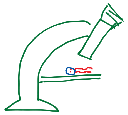DIMOVA LAB
Biomembranes and more
The interior of living cells is crowded with macromolecules and organelles. Interactions
between macromolecules can lead to the formation of coexisting aqueous phases. Thus,
in the concentrated environment in the cell, local phase separation may occur, involving
local composition differences and microcompartmentation. Some years ago, we started
working with vesicles encapsulating aqueous two-
● Lipid membranes in contact with aqueous phases of polymer solutions, R. Dimova
and R. Lipowsky, Soft Matter, 8, 6409-
● Giant vesicles exposed to aqueous two-
● Giant vesicles encapsulating aqueous two-
Vesicles with aqueous compartments
Aqueous droplets of polymer solution can undergo wetting transition when in contact with the membrane [read more]
On microscopic scale the membrane exhibits a kink which cannot persist on nanometer scale where the wetting is characterized by an intrinsic contact angle [read more]
A vesicle (red) wetted by a droplet of polymer solution (green) [read more]
Nanotubes stabilized by spontaneous curvature [read more]
Last modified: 13-

